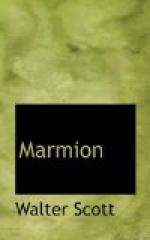’With what gratification those Epistles were read by the friends to whom they were addressed it is superfluous to show. He had, in fact, painted them almost as fully as himself; and who might not have been proud to find a place in such a gallery? The tastes and habits of six of those men, in whose intercourse Scott found the greatest pleasure when his fame was approaching its meridian splendour, are thus preserved for posterity; and when I reflect with what avidity we catch at the least hint which seems to afford us a glimpse of the intimate circle of any great poet of former ages, I cannot but believe that posterity would have held this record precious, even had the individuals been in themselves far less remarkable than a Rose, an Ellis, a Heber, a Skene, a Marriott, and an Erskine.’
William Stewart Rose (1775-1843), to whom Scott addresses the Introduction to Canto First, was a well-known man of letters in his time. He addressed to Hallam, in 1819, a work in two vols., entitled ‘Letters from the North of Italy,’ and escaped a prohibitory order from the Emperor of Austria by ingeniously changing his title to ’A Treatise upon Sour Krout,’ &c. His other original works are, ‘Apology addressed to the Travellers’ Club; or, Anecdotes of Monkeys’; ‘Thoughts and Recollections by one of the Last Century’; and ‘Epistle to the Hon. J. Hookham Frere in Malta.’ His translations are these:—’Amadis of Gaul: a Poem in three Books, freely translated from the French version of Nicholas de Herberay’ (1803); ’Partenopex de Blois, a Romance in four Cantos, from the French of M. Le Grand’ (1807); ’Court and Parliament of Beasts, translated from the Animali Parlanti of Giambatista Casti’ (1819); and ‘Orlando Furioso, translated into English Verse’ (1825-1831). The closing lines of this Introduction refer to Rose’s ‘Amadis’ and ‘Partenopex.’
Ashestiel, whence the Introduction to the First Canto is dated, is on the Tweed, about six miles above Abbotsford. ’The valley there is narrow,’ says Lockhart, ’and the aspect in every direction is that of perfect pastoral repose.’ This was Scott’s home from 1804 to l812, when he removed to Abbotsford.
--------------------
lines 1-52. This notable winter piece is the best modern contribution to that series of poetical descriptions by Scottish writers which includes Dunbar’s ‘Meditatioun in Winter,’ Gavin Douglas’s Scottish winter scene in the Prologue to his Virgil’s Aeneid vii, Hamilton of Bangour’s Ode iii, and, of course, Thomson’s ‘Winter’ in ‘The Seasons.’ The details of the piece are given with admirable skill, and the local place-names are used with characteristic effect. The note of regret over winter’s ravages, common to all early Scottish poets, is skilfully struck and preserved, and thus the contrast designed between the wintry landscape and ‘my Country’s wintry state’ is rendered sharper and more decisive.




